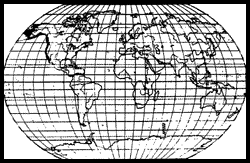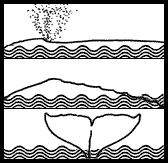(republished from ACSONLINE.org)
 |
|
| The only member of the family Eschrichtiidae, the gray whale is a mysticete, or baleen whale. It is a "coastal" whale that migrates along the North American Pacific Coast between arctic seas and the lagoons of Baja California, Mexico. Frequently visible from shore, gray whales provide a unique opportunity for land and boat observation, and commercial whalewatching has become a major industry along its migration route. Visitors to the calving and breeding lagoons sometimes encounter the phenomenon of the "friendlies"; gray whales that closely approach small boats and allow themselves to be touched by humans. |
PHYSICAL DESCRIPTION
Gray whales have a streamlined body, with a narrow, tapered head. The upper jaw is arched in profile, and slightly overlaps the lower jaw. The rostrum (upper jaw) is dimpled and each of the little depressions contains one stiff hair. There are 2-5 grooves on the ventral throat 5 feet (1.5 m) in length.
COLOR
The gray whale received its name from the gray patches and white mottling on its dark skin. On the skin are many scratches, scattered patches of white barnacles, and orange whale lice. Newborn calves are dark gray to black, although some may have distinctive white markings.
FINS AND FLUKE
The gray whale has no dorsal (top) fin. About 2/3 of the way back on its body is a prominent dorsal hump followed by a series of 6-12 knuckles along the dorsal ridge that extend to the fluke (tail). Its flippers are paddle shaped and pointed at the tips. Its fluke is about 10-12 feet (3.7 m) across, pointed at the tips, and deeply notched in the center.
LENGTH AND WEIGHT
Adult males measure 45-46 feet (13.7-14 m) and adult females measure slightly more. Both sexes weigh 30-40 tons (27,200-36,300 kg).
FEEDING
Gray whales feed on small crustaceans such as amphipods, and tube worms found in bottom sediments. They feed primarily during the summer months of long daylight hours in the cold Arctic waters of the Bering and Chukchi seas. As a baleen whale, it has a series of 130-180 fringed overlapping plates hanging from each side of the upper jaw, where teeth might otherwise be located. These plates consist of a fingernail-like material called keratin that frays out into fine hairs on the ends inside the mouth next to the tongue. The plates are off-white and about 2-10 inches (5-25 cm) in length. To feed a whale dives to the bottom, rolls on its side and draws bottom sediments and waters into its mouth. As it closes its mouth water and sediments are expelled through the baleen plates, which trap the food on the inside near the tongue to be swallowed.
MATING AND BREEDING
Gray whales reach sexual maturity at 5-11 years of age, or when they reach 36-39 feet (11-12 m) in length. Gestation is 12-13 months. The calf weighs 1,100-1,500 pounds (500-680 kg) and is about 15 feet (4.5 m) at birth. Calves nurse 7-8 months on milk that is 53% fat (human milk is 2% fat). Females bear a single calf, at intervals of 2 or more years. Courtship and mating behavior are complex, and frequently involve 3 or more whales of mixed sexes. Mating and calving both occur primarily in the lagoons of Baja California, Mexico, although both have been observed during the migration.
DISTRIBUTION AND MIGRATION
Gray whales inhabit shallow coastal waters of the eastern North Pacific. The gray whale makes one of the longest of all mammalian migrations, averaging 10,000-14,000 miles (16,000-22,530 km) round trip. In October, the whales begin to leave their feeding grounds in the Bering and Chukchi Seas and head south for their mating and calving lagoons in Baja California, Mexico. The southward journey takes 2-3 months. The whales remain in the lagoons for 2-3 months, allowing the calves to build up a thick layer of blubber to sustain them during the northward migration and keep them warm in the colder waters. The return trip north takes another 2-3 months. Mothers and calves travel very near shore on the northbound migration. There are some individual gray whales that are found year round in the Straits of Juan de Fuca between the State of Washington and Vancouver Island, Canada and possibly off the central California coast.
NATURAL HISTORY
A migrating gray whale has a predictable breathing pattern, generally blowing 3-5 times in 15-30 second intervals before raising its fluke and submerging for 3-5 minutes. A gray whale can stay submerged up to 15 minutes, and travel at 3-6 miles per hour (4.8-9.6 km/hr). Mothers are very protective of their calves, and earned the name "Devilfish" from early whalers in the lagoons because of their violent defensive behaviors. Orcas (killer whales) are a cause of gray whale deaths, and many gray whales have orca teeth scars on their flukes.
STATUS
At one time there were three gray whale populations: a north Atlantic population, now extinct, possibly the victims of over-hunting; a Korean or western north Pacific stock now very depleted, also possibly from over-hunting; and the eastern north Pacific population, the largest surviving population. Hunted to the edge of extinction in the 1850's after the discovery of the calving lagoons, and again in the early 1900's with the introduction of floating factories, the gray whale was given partial protection in 1937 and full protection in 1947 by the International Whaling Commission (IWC). Since that time the eastern North Pacific gray whale population has made a remarkable recovery and now numbers between 19,000 and 23,000, probably close to their original population size.
 |
 |
| Gray Whale Distribution Map |
Blow, Dorsal Fin and Fluke Diagram |
Selected Literature
Balcomb, K. and S. Minasian. 1984. The World's Whales. Smithsonian Books. W. W. Norton, New York.
Ellis, R. 1980. The Book of Whales. Alfred A. Knopf, New York.
Gohier, F. 1988. A Pod of Gray Whales. Blake Publishing, San Luis Obispo, California.
Leatherwood, S.L. and R.R. Reeves. 1983. The Sierra Club Handbook of Whales and Dolphins. Sierra Club Books, San Francisco.
Miller, T. 1975. The World of the California Gray Whale. Baja Trail Publications, Inc., Santa Ana, California.
Swartz, S. and M.L. Jones. 1984. The Gray Whale. Academic Press, San Diego.
May be reprinted for educational or scientific purposes.